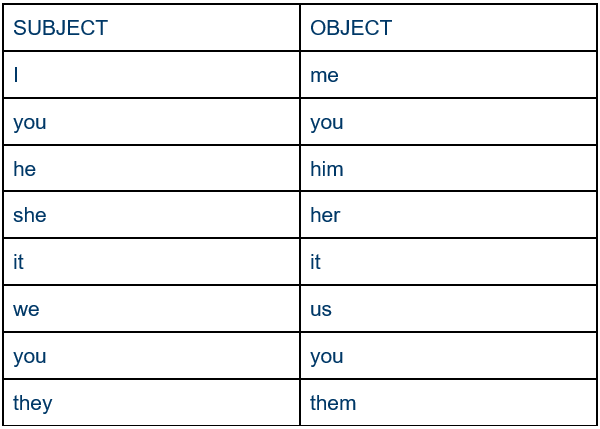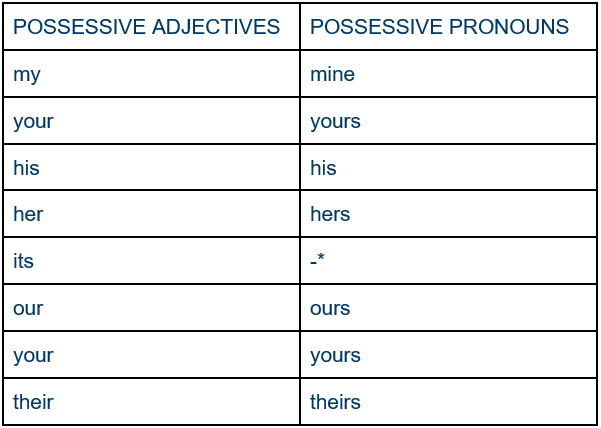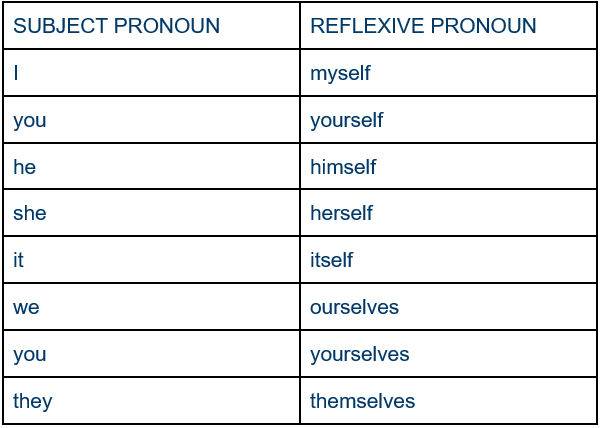Pronouns
One of the hardest things all language students face, especially as beginners, is learning how to use the various types of pronouns. They’re small words but transform the meaning of a sentence. Are you unsure about which pronoun to use? Do you sometimes get blocked in the middle of a phrase, trying to choose between he and him? If so, read on to review all the English pronouns.
What is a pronoun?
A pronoun is a word that substitutes a noun. We use pronouns when the listener/reader knows who or what we’re referring to. For example,
This is Mika. She’s a manager.
Once you know who I’m talking about (in this case Mika), I can refer to the person using the pronoun, she.
Personal pronouns
We use personal pronouns to substitute the names of people and things. These can be either subject pronouns or object pronouns. Subject pronouns refer to the person that does the action (the verb), while object pronouns receive the action so come after a verb or a preposition. For example,
John teaches Sara. = He teaches her. (subject + verb + object)
You work with me. (subject + verb + preposition + object)
Here are all the personal pronouns:

Here are some examples:
There’s Paul. Do you know him?
They can pick us up at 5 p.m.
These reports are for Sue. I must give them to her.
Can you give me a hand with this box? It’s heavy.
Tom is the CEO. I don’t think he knows me.
You’re having dinner with some clients tomorrow. They’re meeting you at the restaurant.
Possessive pronouns
These pronouns indicate who owns (has) something. They are similar to possessive adjectives but are not followed by the noun. For example,
Whose is this pen? – It’s mine. (= my pen)
Here are all the possessive pronouns along with the adjectives:

*There is no possessive pronoun for ‘it’ because it would be too unclear what the meaning was.
Here are some examples of possessive pronouns:
This jacket is yours.
That’s Tom’s scarf and those gloves are his too.
Is that Sue and Paul’s car? – No, theirs is black.
Here’s your table and this one is ours.
Is this Anna’s bag? – Yes, it’s hers.
They aren’t my glasses. Mine are brown.
Reflexive pronouns
We use reflexive pronouns when the object is the same person as the subject. For example,
I taught myself to play the guitar. = I learned the guitar on my own.
There are certain verbs in English that are commonly used with reflexive pronouns, including enjoy, cut, hurt, introduce, teach, express, help, blame.
Here are all the reflexive pronouns:

Here are some examples:
Have you hurt yourself?
Yes, I cut myself when I prepared the vegetables.
She blames herself for the accident, but it wasn’t anyone’s fault.
The kids really enjoyed themselves at the park.
Would you all like to introduce yourselves?
He wants to teach themself to ski, but it’s better to have lessons.
Relative pronouns
When you want to connect phrases and refer to a person or thing, you can use a relative pronoun.
who – for people
which – for things
that – for people and things
where – for places
Here are some examples:
This is the man who helped me yesterday.
An engineer is someone who designs machines.
There are many websites which can help you find a job.
This is the type of computer that I want.
A bakery is a place where you can buy bread.
Do you know a good university where I can study history?
Being able to use the right pronoun is essential, especially when you use English at work. Practice using them as much as you can, above all by speaking, so that you’re well-prepared when you need to say them in a real-life context. Start practicing now by doing this fun quiz.
The past continuous is one of main tenses used to describe situations in the past in English. What is the difference between Past Simple and Past Continuous? Read on to find out!
There are several different ways to talk about the future in English, and one of the most common is ‘Be going to’. Read more and practice it now.